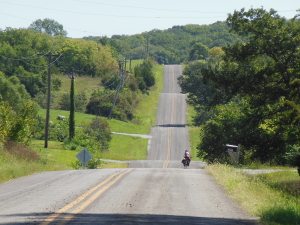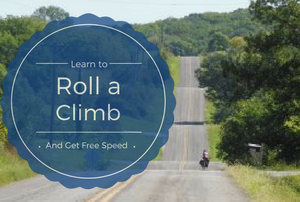Most people think a climb is over when you crest the top. That's just not true. In fact, the top of any climb is just the beginning of something else. And that something else can be one of the greatest tricks in your arsenal.
To put in perspective how you can add a powerful weapon to your climbing quiver, let me ask you a question: How many times have you seen someone crest a climb, only to drop their head and soft pedal (or worse, coast) over the crest?
Let me ask you another question: How many times have you seen determined chaser manage to close a big gap by driving through the crest of that climb?
I know I've seen it all the way from the Pro Tour ranks down through the smallest group rides. And I know that the guys riding out the crest of the climb are getting a lot of extra speed that the soft pedalers are missing out on. I'll also tell you something: the physiological cost of that speed is really, REALLY small.
Read more about getting bonus speed in the hills after the break:
 Rolling The Hills
Rolling The Hills
Those guys who drive through the crest of the climb (and into the descent on the other side) are getting a whole bunch of extra speed out of that climb that you might not be getting. If you want to make the most out of your fitness and suddenly find yourself at the head of your group rides in the next month, you need to start “rolling over” your climbs just like the pros do.
What is “rolling a climb” exactly? Rolling a climb is a technique that relies on the forces of gravity to assist you in getting more speed than you have right now. In the case of rolling a climb, it refers to the idea of powering through the crest of the climb and into the descent or false flat on the other side.
To execute the technique, think about the profile of a climb. You spend 6, 8, 10, 30 minutes climbing. Your legs are burning. When the road flattens out or begins to drop, what is the first instinct? It's to stop pedaling and shake out the legs, right?
WRONG!
To properly roll a climb, when you come near the crest of the climb (say with 50 meters to go) you'll want to accelerate just a little bit. I'm not talking all out sprint, although that IS an option, but just add a few percent more to your effort. Once you hit the crest of the climb, you'll want to ramp up your cadence by 10 to 20 RPM and push through the false flat and into the descent. Continue to rev your cadence up as you gain further speed and continue to shift up to keep light tension on the pedals. Continue that for about 20-30 seconds after you crest the climb and I assure you, your buddies will be deep in the rearview mirror.
Why Does It Work So Well?
In the case of a descent on the other side of a climb, you're assisting gravity in propelling you downhill. During that process, you using a lighter gear and lower pedal tension to accomplish this which provides a little bit of rest for the muscles by decreasing the time of muscular contraction necessary to produce force. In addition to the lighter gear and lower pedal tension, the higher cadence actually helps to promote blood flow through the muscles (muscle compression increases venous return to the heart) and helps to remove some of the metabolic wastes generated by the climb. This will ensure quicker recovery from the climb while giving you a solid burst of speed that your riding buddies won't expect.
Where Do I Use It?
This technique works really, REALLY well in rolling terrain, as it slingshots you out of one rolling climb and into the next one. It works equally well on longer climbs too: you'll be turning the screws on your buddies who are just hoping to recover a little bit as they hit the crest. To do it, you need to use all that neuromuscular skill and leg speed you practiced over the winter to power through the crest and descent of a climb. Basically, once you hit the crest of the climb, you need to continue powering through the crest or flat at the top of the climb, and once you start descending, you need to ramp up the cadence and row through the gears to keep the pressure on.
Try this trainer workout to simulate what it's like to roll over a climb so you can get an idea of how much it hurts and how effective it can be:
This workout is a perfect way to inject some fun into your trainer rides and will teach you to automatically roll hills once you get outdoors. Your group riding buddies will wonder where you learned to terrorize them in the hills so much, which is just plain fun.
If you want a more in-depth look at rolling over climbs, check out my HIT Climbing Power Rollover in my training plan store.

